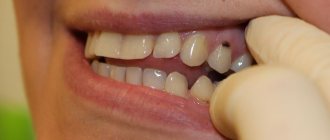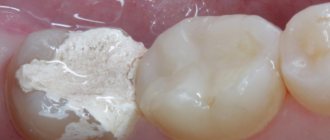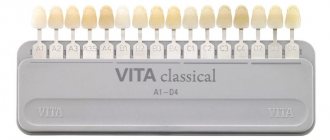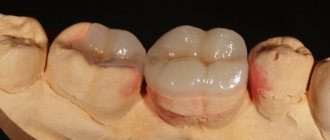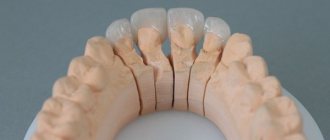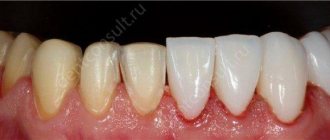Many patients do not know that they can put fillings on their front teeth. Its goal is not only to eliminate defects, but also to restore anatomical, physiological and aesthetic properties.
The procedure is quite popular. In order for the result to please the patient, it is necessary to choose a competent specialist with extensive experience. A professional will select the necessary material individually for each type of teeth and install the product so that it will not be noticeable in the smile area.
Installing a temporary filling
A filling between the front teeth is often placed due to carious lesions. For several days, it protects healthy tissues and nerve endings from external influences.
After a session of cleaning the canals and removing the nerve, the structure is replaced with a permanent one.
Life time
temporary product depends on the need for installation. As a rule, it is worn for no more than one month. Lasts about three days if arsenic is present.
When treating pulpitis or advanced stages of caries, the reaction of the unit is checked. Antibiotics are applied under the material. In this case, you need to walk for at least three weeks. The installation method is identical.
The following can be used as the main material:
- polycarboxylate cement,
- dentine,
- vinoxol,
- karyosan,
- softened paste
Types of suitable fillings
Modern dentistry offers a large selection of filling materials, differing in their properties and, of course, price:
| Name | Modern materials | Properties, advantages and disadvantages |
| Cement fillings | glass ionomer | This composition of fillings is characterized by good integration with natural tissues, which ensures the reliability of the insert and, subject to careful treatment of the drilled cavity, reduces the threat of recurrent caries in the patient. |
| Compomers | hybrid version of glass ionomers and composite ingredients | Aesthetically identical to enamel, high-quality materials are excellent for plastic surgery of anterior molars after chipping. The only downside of fillings is that they are not strong enough, so after filling, the dentist advises not to overload the affected molar. |
| Photopolymer | mixed organic and inorganic compounds that harden when exposed to light | These are the most common filling options for front teeth. The composition quickly hardens under the influence of an ultraviolet lamp. By adding or subtracting various ingredients, the dentist can easily select the desired color to match the dentition, so such cosmetic fillings are also invisible to others. |
| Metal | gold, copper, silver | Metal structures are the most durable. On the other hand, they are unaesthetic, shrink due to the chewing load and are not tightly attached to the dental crown, which is fraught with repeated caries. The use of material for the anterior masticatory organs is rare. |
| Plastic | acrylic-containing plastics, carbondent | Plastic analogues quickly harden, are characterized by increased strength, are resistant to chemical reagents, and do not have a negative effect on the patient’s oral cavity. However, the composition is prone to wear and does not hold the shade well enough. Over time, such a tooth will darken. |
| Silicate | silicate cement | These types of fillings are budget ones. They are quite durable. However, they have weakened adhesion, which is fraught with re-infection of the molar, and can release toxic substances. |
| Chemical | the main component in them is porcelain | The material is durable and is characterized by uniform hardening during a chemical reaction with the oral cavity and auxiliary components. Due to increased adhesion, the filling is almost invisible on the surface, which makes it aesthetically attractive. |
| Temporary fillings | dentin, softened paste, cariosan, vinoxol | Modern temporary filling materials are used during long-term therapy to fill the cavity so that the patient can chew comfortably. This option is not suitable for permanent use due to aesthetic imperfections, poor strength and insufficient integration. |
All of the listed filling compositions can be used in the dental treatment of anterior molars. Their pros and cons appear depending on the location of the caries and its size.
In general, when there is more damage, stronger compounds are used, and when there is a small chip, more natural and aesthetically attractive ones are used.
Replacing a filling
Sometimes it becomes necessary to change fillings on the front teeth. Replacement is due if it is fixed:
- Violation of the integrity of the closure of the carious cavity. This process provokes infection.
- Vertical or horizontal shrinkage of material.
- Heavy load due to chewing. Because of this, destruction occurs.
- The development of periodontal tissue diseases - gingivitis, periodontitis.
- Overhang of the edges on the gum.
- Wear due to flat occlusal surface.
- Change in the shade of an artificial tooth (usually darkening).
- Poor quality of oral hygiene.
- Diastema of the frontal units.
- Changing the inclination.
- Insufficient cleaning of dental plaque in the area adjacent to adjacent molars.
Dental filling. Filling technique
As you know, the most common materials for filling teeth are light-curing composites. Taking this fact into account, let’s consider the technology for installing a photocomposite filling.
The method of filling a tooth directly depends on the volume and depth of the carious process. Based on the depth of the carious cavity, caries is classified as: superficial, medium and deep. With superficial caries, the carious defect is located within the enamel. In moderate cases, the enamel is affected and the dentin is affected. With deep caries, the enamel is damaged and a significant layer of dentin is destroyed by caries.
Superficial caries
Average caries
Deep caries
After the carious cavity is prepared for filling, the tooth must be isolated from saliva. Failure to comply with this requirement can lead to wetting of the prepared cavity with saliva and, as a result, cause a violation of the tightness of the filling to the tooth. This leads to caries at the interface between the filling and the tooth, and can also cause the dental filling to “fall out”.
To isolate teeth from saliva, cotton swabs are used, or a more reliable method is isolation using a rubber dam. A rubber dam (or rubber dam) is a thin sheet of latex rubber. Using a special technique, the rubber dam sheet is placed on the tooth, creating a dry working field. Saliva is removed from the mouth using a saliva ejector.
Figure 1: Rubber dam sheet.
Fig. 2: Clasps are metal clips for fixing the rubber dam to the tooth.
Figure 3: Tooth isolated with rubber dam.
Then acid etching of the prepared cavity is carried out using 37% phosphoric acid. This is done in order to remove the so-called “smear layer” and increase the contact area between the surface of the tooth cavity and the filling. During etching, the acid dissolves the inorganic components of the tooth tissue, creating a rough surface. After 20–60 seconds, the acid is washed off with water and the tooth is dried with air.
The next step is to introduce the so-called “bond” into the cavity - its function is to create an “adhesive” layer for reliable “adhesion” of the filling to the tooth tissue.
Applying bond to the walls of the prepared cavity
After bonding, the walls of the cavity are covered with a special special flowable composite. Thanks to its fluidity, it penetrates into all microcavities, creating a thin and smooth “adaptive” layer. This layer helps relieve mechanical stress from the walls of the tooth cavity. Then the flowable composite introduced into the cavity is cured with the light of a special dental lamp.
Dental curing lamp
Light curing of fillings
The filling material is directly introduced into the cavity in portions and evenly distributed in it. After which it is cured with lamp light. So, layer by layer, the entire cavity is filled. It is very important that the thickness of each layer does not exceed 2 mm. This requirement is associated with polymerization shrinkage of the photocomposite (reduction in volume during curing) and the inability to polymerize a “thick” layer of the composite with lamp light. If this rule is not followed, a microgap may form between the filling and the tooth tissue, which leads to recurrent caries. This mistake can also cause pain after the filling is placed.
So, the light seal is “installed”. Now it should be processed, i.e. give the restored tooth the correct anatomical shape and polish the filling. Pre-treatment of the filling is carried out using diamond or carbide burs. Excess filling material is removed, sharp edges are smoothed, and the filling is given a relief characteristic of a given tooth. To control the full contact between the restored tooth and the antagonist (a similar tooth in the opposite jaw), carbon paper is used. When the teeth are closed, the paper leaves an imprint on the filling in the place where the contact is excessive. This point is sanded. This operation is repeated until optimal contact between the antagonists is achieved. For final processing of the filling, polishing rubber bands, abrasive discs and strips are used. After which the filling is polished with a special polishing paste and coated with a protective varnish.
Clinical example of dental restoration with heliocomposite
A: Initial situation (amalgam fillings requiring replacement).
B: The fillings are removed and the resulting cavities are etched and covered with bonding agent.
C, D, E: Stages of restoration of the second upper premolar.
Type of completed dental restoration
Features of treatment of medium and deep caries
In medium and, especially, deep caries, the layer of tooth tissue separating the bottom of the carious cavity from the pulp chamber (the inner part of the tooth where the “nerve” is located) can be very thin. As a result, after placing a filling, a complication may occur - pulpitis (inflammation of the nerve of the tooth). Pulpitis, in this case, can be provoked by chemical irritation of the pulp by dental preparations used to treat the carious cavity.
Also, a significant area of exposed dentin (the inner tissue of the tooth containing nerve endings) can cause pain after tooth filling. In order to prevent these undesirable consequences, before placing a filling, the inner surface of the prepared cavity is covered with a thin layer of glass ionomer cement. The cement layer promotes the regeneration of tooth tissue and isolates sensitive dentin from the irritating effect of the etchant acid.
In case of deep caries, a special therapeutic pad is applied to the bottom of the cavity. It contains calcium hydroxide, which helps restore dentin from the pulp chamber. Then a layer of glass ionomer cement is applied over the treatment pad, after which a filling is placed.
A “good” filling will be obtained if the above principles of caries treatment are observed. In other cases, the filling will most likely not be “good” enough.
Painfulness of the procedure
Most people are afraid of the procedure precisely because of toothache, but modern technology and the use of anesthesia eliminate this ailment.
The session is completely painless. To reduce the likelihood of discomfort, all manipulations are carried out after the administration of an anesthetic. If there is no nerve, the procedure is performed without anesthesia. The patient may feel slight pressure on the gum.
An exception is intolerance to certain medications used for anesthesia. The choice is made in favor of a similar drug with a different active substance.
After the injection, no painful sensations are observed.
It hurts if there is a strong inflammatory process at the root apex and in the canals. Unpleasant sensations occur only when the drug gets into the periodontal tissues. They go away instantly after increasing the dosage of the painkiller.
Some pain is possible if there is a deep stage of carious lesions, depulpation or canal treatment is performed, or sensitivity is increased.
Installation on the front teeth
The procedure takes from half an hour to an hour and a half, depending on the complexity of the problem.
The stages of setting up the frontal units are as follows:
- Carrying out professional oral hygiene. The hygienist cleans the molars and interdental space from plaque.
- Determination of tone.
- Introduction of anesthesia. The anesthetic is selected taking into account the patient's tolerance to the active substance. The injection is given in the gum area.
- Removal of caries. If the pathology affects only the superficial layers, then the disease is eliminated by grinding.
- Removal of the inflamed area of the pulp.
- Preparing the plane. The dentist treats the surface with a drill.
- Acid and adhesive treatment of dentin and enamel for better adhesion.
- Treatment with an antiseptic solution. This point is important in order to reduce the risk of microbial development.
- Application of material. It hardens quickly, so it is important to “shrink” it immediately with a special tool.
- Bite check. To do this, the doctor asks the patient to bite down on a plate of dye. When a certain area of this element is painted, a violation is considered.
Performing grinding and polishing of the artificial surface for proper bite and ideal smoothness.
When restoring the anterior dentition, diastema closure is often performed. This is possible if the spaces between the central molars are small. More material is applied to the incisors to increase their width. Thus, the distance between them disappears.
Types of fillings for front teeth
The design on the frontal incisors must have such properties as resistance to abrasion and destruction, biocompatibility, thermal conductivity to protect against exposure to different temperatures, and matching the enamel in structure and shade.
There are several types of materials. They have their own characteristics:
- Cement silicophosphate
(zinc phosphate or polycarboxylate) material. Among the advantages, it is worth highlighting the low cost. However, there are many more disadvantages: Firstly, fixation and adherence to the walls is insufficient. Secondly, the color is noticeably different, since the cement quickly acquires a yellowish tint. Thirdly, the surface of the artificially created unit is poorly polished. - Composite
The structure, shape and color of a natural incisor are most clearly conveyed. It is characterized by increased strength. The downside is the risk of roughness if the material is not mixed well. - Plastic.
Its advantages include a tight fit, aesthetic component and mechanical strength of the material. The color palette is wide and you can easily choose a shade to match the color of your teeth. The negative aspects are that the plastic darkens and turns yellow, the surface gradually becomes rough, acrylic releases toxins and also shrinks.
When choosing, you need to know how long different types of fillings last. Cement is short-lived. Their service life does not exceed one and a half years. Plastic products last up to three years. Good composite fillings last up to five years.
Putting a light filling on a tooth: how the treatment process will proceed
Treatment and restoration of a tooth with a light filling always begins with an examination of the patient’s oral cavity - this is necessary to make a diagnosis and select the correct treatment plan. If the examination is not enough for an accurate diagnosis, the patient is sent for an X-ray. Further tooth treatment and installation of a light filling will include the following steps:
1. Local anesthesia is given. The installation of the light filling itself is painless, but before this event the dentist will need to treat the tooth tissue and this can cause pain to the person.
2. The tooth being filled is protected from saliva by a rubber dam - a special latex lining that will prevent moisture from entering the cavity being treated. Even the smallest particles of moisture can negatively affect the strength and reliability of the restoration!
3. The dentist works with a diseased tooth, removing teeth damaged and destroyed by caries and forming a cavity for installing a filling. If caries has destroyed the tooth almost to the pulp, removal of the dental nerve may be required, as well as treatment and filling of the dental canals.
4. Having formed and treated the cavity in the tooth with antiseptics, the doctor will begin choosing the shade of the future light filling. A special scale is used for this; the dentist can also mix several shades of photopolymer material to obtain the color of the light filling that will perfectly match the tone of the natural tooth enamel.
5. The tooth cavity is dried and covered with a preparation based on orthophosphoric acid for 40 seconds. This drug improves the adhesion of the light filling to the natural tissues of the tooth.
6. After the specified exposure time, the drug with adhesive properties is washed off, and the cavity is thoroughly dried again.
7. Adhesive is applied to the tooth tissue, and then the doctor will begin laying out the filling material in layers. Each laid layer is exposed to ultraviolet radiation to ensure high-quality hardening and increase the strength of the light seal.
The procedure for installing a light filling ends with grinding and polishing of the restoration. On average, it takes a dentist 40-50 minutes to install one medium-sized filling.
Naturally, the treatment process and installation of a light filling for pulpitis and periodontitis will be longer. After all, before placing a light filling on a tooth, the doctor must make sure that the inflammatory process is completely eliminated.
The best choice of fillings for front teeth
The filling must close the cavity and prevent infection of the canals. In the case of front teeth, the aesthetic aspect comes to the fore, so the material must have the appropriate properties.
The most durable fillings for damaged front teeth are light products
. They are made from a material that hardens under ultraviolet rays. The composition contains heliocomposite, glass-ceramic filler, and resin.
Durability of photopolymers
Photopolymers are characterized by increased strength. They can last up to 10 years. They are resistant to temperature, restore length and shape.
Reflective filling has many advantages
:
- Eating food and water is allowed immediately.
- Increased adhesive ability.
- Plastic. The material allows you to clean out any pores and cracks.
- Layer-by-layer application. Due to this, the grip is enhanced.
- The percentage of shrinkage is minimal compared to chemical analogues.
- Does not release toxins.
- Possibility of fixing in a small area.
- Possibility of choosing a color that is similar to enamel.
Minus
is high cost. As a result of the use of a UV lamp, the price does not allow the use of a light filling as a temporary structure.
Advantages and disadvantages of light fillings on teeth
Compared to other types of fillings, light fillings have a number of advantages:
- The high plasticity of the material gives the dentist the opportunity to form a high-quality filling and, therefore, to thoroughly fill the cavity and all surface defects of the tooth being restored. The same quality of light fillings makes it possible to apply the material in layers and thereby ensure maximum strength of its adhesion to the natural tissues of the tooth;
- Hypoallergenic. All components included in the light fillings are not capable of causing allergic reactions in people;
- Light fillings make it possible to accurately reproduce the color of natural tooth enamel. To obtain the desired shade of the filling that is planned to be placed on the tooth, the dentist can mix several shades of material;
- Even when the material has completely hardened, the light fillings can still be properly sanded and polished. This has a positive effect on the level of aesthetics of the finished restoration.
But despite the large number of advantages, light fillings also have certain disadvantages. In particular, a light filling cannot be placed on a tooth if the tooth is significantly damaged. In addition, over time, such restorations can chip and change color. In this case, you will need to replace the light seal.
Yellowing of fillings on front teeth
Patients often experience discoloration of artificial units.
Causes
Common causes of pathology are:
- Getting injured.
- Secondary caries.
- Drinking black tea or coffee.
- Smoking.
Darkening is possible when the nerve is removed.
Correction methods
The first step is to carry out the whitening procedure. You can get rid of yellowing only with photopolymers. Only if the structure has lightened slightly does it need to be replaced.
Whitening methods
Photopolymers are bleached using the in-channel method. A special gel is injected into the root canal and a temporary structure is placed. After 2-3 procedures, the shade becomes lighter, and the structure is replaced with a permanent one.
Lost filling on a front tooth
Causes
The reason for material loss may be:
- Neglect of oral hygiene and, as a result, plaque formation.
- Untimely removal of tartar.
- Inflammation of the pulp.
- Mechanical injuries.
- Chewing food with frontal incisors.
- Poor tooth preparation before the procedure.
- Eating seeds, nuts, etc.
- Excessive load on the front units. For example, opening lids, chewing threads, etc.
Elimination methods
With high-quality elimination of carious cavities, correction is carried out within a month. If the product was placed in the treatment of deep caries, then you should immediately contact the dentist to exclude an infectious process.
Treatment is prescribed depending on the cause of the loss. If there is repeated caries or loss of a pulpless tooth, re-installation does not make sense. The doctor suggests installing a pin or crown.
What to do if a piece of the filling breaks off
In this case, you should immediately visit a dentist
. The doctor will correct the problem in one visit if no spread of secondary caries is noticed.
If the chip occurs from the edge, then the restoration is carried out with the same material that was originally used. If a significant part has broken off, the doctor suggests changing the material or performing a complete restoration and extension.
Light fillings on teeth: service life and tips to help avoid fillings falling out
If, after treating the tooth and installing a light filling, you strictly follow all the doctor’s recommendations, the restoration can serve you for 7-10 years without breaking or losing its visual appeal. In particular, you need to brush your teeth daily (at least twice a day), using not only a toothbrush and toothpaste, but also dental floss and mouthwash.
It is important to monitor your diet - it should contain a minimum of sweet foods and as much food rich in calcium as possible.
Smokers, people who abuse coffee and tea may need to change the filling earlier, as it may change its color from contact with the pigments of tobacco and drinks.
If you do not want the installed light seal to chip or fall out, do not do the following:
- Do not use ultrasonic brushes to clean your teeth, this can lead to loosening and loss of the filling;
- Remember that smoking and alcohol abuse can lead to a rapid loss of the aesthetic appearance of the light filling;
- Do not pick the line between the filling and the tooth with toothpicks.
If the filling suddenly chips, falls out, or you just want to restore its aesthetic appearance, do not try to restore it yourself, following advice from the Internet - contact the dentist.
The filling on the front teeth interferes after treatment
In some cases, the design on the frontal incisors prevents the mouth from closing completely; the roughness injures the tongue or the mucous membrane of the lips.
Causes
Trouble arises if sufficient grinding and grinding of the excess surface has not been carried out.
Much less commonly, the cause is an excess of applied material when correcting the interdental gap on the front teeth.
The rarest situation occurs when the wall between the filling and the pulp chamber is thinned. There is a feeling of discomfort that irritates the nerve.
Complications
Ignoring pathology can lead to unpleasant consequences. For example:
- The high position of the artificial structure causes a lot of pressure on the jaw. Pulpitis and periodontitis gradually develop.
- Increases the likelihood of chipping.
- Uneven closing of the jaw contributes to its dislocation and other diseases of the temporomandibular apparatus.
Popular questions
What to do if the filling composition has changed color (darkened, yellowed, blackened)? How to bleach?
The filling composition changes its color over time, just like tooth enamel. However, it is less susceptible to whitening with pastes and gels. Therefore, it is best to go to the clinic so that the doctor will bleach the filling using professional means or remove some material from the surface and replace it with a new one.
Is the filling visible after treatment?
With modern equipment and materials, photopolymers do not stand out in any way against the background of the dental surface of a molar.
What should you do if the filling on your front tooth falls out, peels off, or breaks off?
In this case, you need to make an appointment with the dentist for re-treatment. If the chip is small, the therapist will only sand it a little so that it does not deteriorate further and does not scratch the tongue. If a large part falls off or falls out completely, you will have to replace it entirely.
What to do if it was placed ugly?
Aesthetics is one of the important components of dental therapy. The patient has the right to demand re-treatment from the clinic administration.
What is a temporary filling for front teeth?
A temporary structure is placed for long-term treatment, which requires several sessions of visiting the dentist. Such a filling is needed to prevent food debris from packing into the opened cavity and for the patient’s convenience.
What is a bite filling for anterior teeth?
This is also a temporary analogue, only larger in size. It is necessary to wear it when wearing braces, so that when closing the chewing organs do not disturb the structure and do not deform it. Also, a bite filling is used for severe chips during long-term dental treatment.
Is it possible to build up a front tooth with a filling?
Modern filling compositions are designed not only for filling carious cavities, but also for restoration after chips. At the same time, the strength of the extended molar will allow you to bite and chew food normally.
What is better – a filling or a veneer?
Both technologies have pros and cons. In particular, veneers have better aesthetic properties and plaque does not settle on them, while filling takes less time and the filling lasts longer.
Before and after installing fillings on the front teeth

